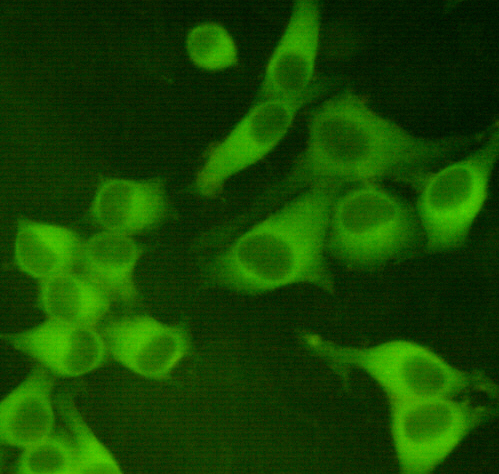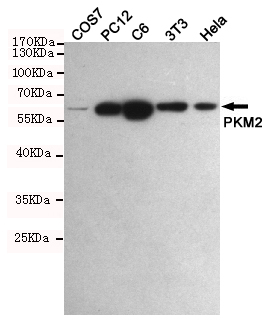-
Product Name
Anti-PKM2 (1A7) Mouse antibody
- Documents
-
Description
PKM2 (1A7) Mouse monoclonal antibody
-
Tested applications
WB, ICC/IF
-
Species reactivity
Human, Mouse, Rat, Monkey
-
Alternative names
CTHBP;Cytosolic thyroid hormone binding protein;Cytosolic thyroid hormone-binding protein;KPYM_HUMAN;MGC3932;OIP 3;OIP-3;OIP3;OPA interacting protein 3;Opa-interacting protein 3;p58;PK muscle type;PK antibody; muscle type;PK2;PK3;PKM;PKM2;pykm;Pyruvate kinase 2/3; antibody
-
Isotype
Mouse IgG1
-
Preparation
Antigen: Purified recombinant human PKM2 protein fragments expressed in E.coli.
-
Clonality
Monoclonal
-
Formulation
Purified mouse monoclonal antibody in PBS(pH 7.4) containing with 0.03% Proclin300 and 50% glycerol.
-
Storage instructions
Store at 4°C short term. Store at -20°C long term. Avoid freeze / thaw cycle.
-
Applications
WB: 1/1000
;ICC: 1/400
-
Validations

Immunocytochemistry staining of Hela cells fixed with 4% Paraformaldehyde and using anti-PKM2 mouse mAb (dilution 1:400).

Western blot detection of PKM2 in COS7,PC12,C6,3T3 and Hela cell lysates using PKM2 mouse mAb (1:1000 diluted).Predicted band size:60KDa.Observed band size:60KDa.
-
Background
Swiss-Prot Acc.P14618.Pyruvate kinase is a glycolytic enzyme that catalyses the conversion of phosphoenolpyruvate to pyruvate. PKM2 is shown to be essential for aerobic glycolysis in tumors, known as the Warburg effect.
Related Products / Services
Please note: All products are "FOR RESEARCH USE ONLY AND ARE NOT INTENDED FOR DIAGNOSTIC OR THERAPEUTIC USE"
